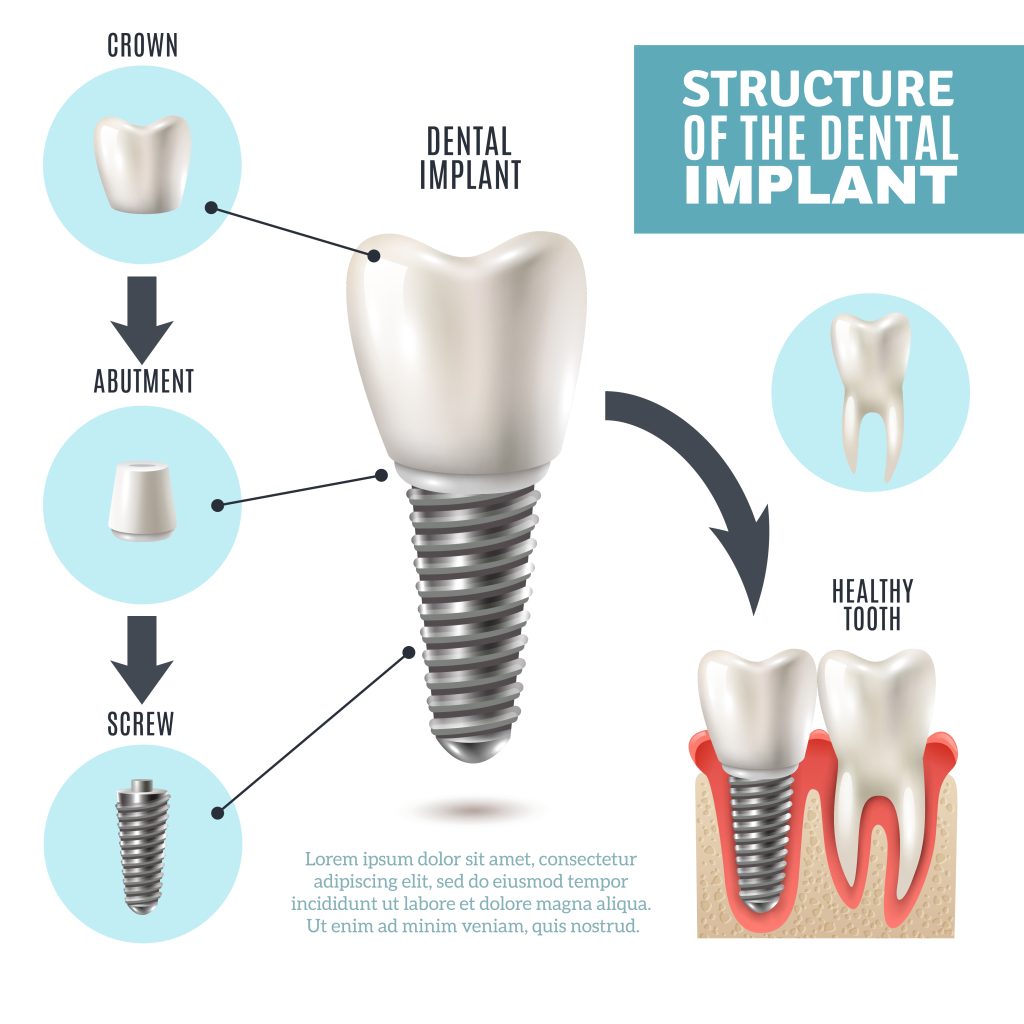What are the best types of dental implants?
In the dental industry, dental implants have emerged as a popular solution for filling gaps or repairing damaged teeth. The option is now widely available as an alternative to traditional procedures. Due to the high rates of success achieved with dental implants, it is considered a valuable treatment option in various situations. Rather than repair or restore a damaged tooth, implants can be used to replace it entirely.

Types of implants
There are three main types of implants:
Endosteal
Dentists insert these dental implants into the jawbone, opting for small screw-shaped devices made of titanium, which are the prevailing implant type.
Subperiosteal
The placement of dental implants is done below the gum level but at, or higher than, the level of the jawbone. This category of implant may be suitable for individuals who have insufficient healthy jawbone and are unwilling or unable to undergo a process of bone augmentation to restore it.
Zygomatic Implants
Among the different types of dental implants, the use of zygomatic implants is infrequent. This method is considered the most complex and should be considered only if the jawbone is insufficient for Endosteal implants.
Instead of positioning the implant in the jawbone, it is situated in the cheekbone of the patient.
Having knowledge of the three kinds of implants, you may now be interested in learning about the procedures of implantation.
Am I a good candidate for dental implants?
patients who require dental implants and periodontal treatments. Our clinic specializes in assessing and providing appropriate care for patients with missing teeth, gum disease, and other oral health issues. We have a team of highly trained and experienced professionals who work together to create individualized treatment plans that meet our patients’ specific needs.
Clicking on the link will launch a fresh browser window that will take you to the American Academy of Periodontology’s website.
The below information pertains to individuals who are considering dental implant surgery:
Bone
If a tooth is absent, the encircling bone starts to disintegrate. A specific quantity of bone is required for the post to combine with it. However, if you have been without a tooth for an extended period, there might not be sufficient bone to facilitate dental implant operation.
To establish this, we make use of a CBCT scanner. This modern advancement enables us to have a three-dimensional vantage point of your mouth and jawbone, which helps us assess the quantity of your bone. If your bone quantity is sufficient, we will proceed to implement your customized treatment plan.
In case you have insufficient bone for dental implants, there is a possibility of undergoing a bone grafting procedure which can promote the growth of bone and tissue in your body. Once enough bone is generated, the surgery can then be proceeded with.
Age
For successful dental implants, it is best to wait until adulthood when growth and development have ceased.
If you or your offspring are in the early stages of life, you may have to postpone any cosmetic alterations until your face has fully matured. This usually occurs at approximately 16 years of age for females and 18 for males.
For now, our dentists based in Bellevue and Issaquah have the ability to provide a temporary fix for your absent tooth.
Health
To undergo dental implant surgery, it is necessary to have good overall health and oral hygiene like many other surgeries. Dental implants may not be feasible if you have certain medical conditions such as diabetes, gum disease, or if you are a heavy smoker.
You can be confident that our dentists will assess your specific needs and collaborate with your doctor if needed to discover a resolution.

Dental Techniques
Snap-In Overdenture
To maintain the bone level and prevent the lower denture from shifting, two implants are inserted in the canine regions of the lower jaw. This will ensure that eating and speaking are easier. While the denture will continue to sit on the gums and fit similarly to a typical denture at the back.
Multiple Implant Cases
The quantity of implants utilized is based on the jaw’s dimensions and anatomy. This method is incredibly adaptable. Implants are symmetrically positioned within the bone to ensure a final repair is secure. If the patient is weary of dealing with a detachable denture and desires a more lifelike replacement, the implant connections can be replaced to accept screw-retained restorations, which can be maintained the same as natural teeth.
The All-on-4 Technique
To help hold a full denture or a bridge that is screwed onto the jaw, a total of four implants are inserted: two in the canine regions and two on either side towards the rear of the mouth. This approach is particularly effective for those with a small mouth or restricted access.
All-on-4 with Angulated Implants
In situations where a patient’s anatomy does not permit optimal implant positioning, there is an alternative option of placing longer posterior implants at oblique angles to increase the gap between the connections of the implants. This helps to enhance the stability of the final denture or restoration, as the pressure from chewing is spread out across a larger surface area.
Immediate Load Implants
By utilizing this method, a provisional denture or crown can be fixed to the implant immediately following its installation, but only if the implant has achieved initial stability. This implies that the implant is secured during the procedure, which can only be determined at the time of the operation. Since the implants are subjected to pressure while the surgical area is still recovering, they are more prone to failure. As a precaution, patients might be required to maintain a soft diet for several months to give the implants adequate time to fuse with the bone.
Zygomatic Implants
These types of dental implants are known as zygomatic arch implants as they are inserted beneath the patient’s cheekbones through surgery. They are suitable for individuals who have insufficient bone material or poor bone density in the upper arch for holding endosteal implants.

How to Choose the Best Dental Implants for You
For a Single Tooth
One tooth replacement involves a post and crown. A post is placed into the jawbone by the surgeon, which is a painless procedure. It may take up to four months for the post to secure the crown. Finally, the dentist attaches the crown to reconstruct the tooth.
Implant-Supported Bridge for Multiple Teeth
If you have lost several teeth, the most suitable solution would be an implant-supported bridge. This involves a chain of dental implants connecting a set of crown bridges.
However, if there are larger spaces between your stable teeth in your mouth, you may require a different alternative.
Implant-Retained Denture for All Teeth
If you desire dentures that are unchanging and enduring, this is the ideal choice for you.
Advanced oral surgery has enabled the creation of personalized dentures that match the individual contours of your jaw and gums; these dentures can be attached to your jaw through various dental implant choices. The customized design will perfectly complement your specific appearance. For individuals who use removable dentures, this is a permanent remedy.
Treatment in Türkiye:
The medical staff of surgical teams, doctors and consultants in Rehab Türk can provide the best treatment options and free consultations – by striving to keep abreast of the latest medical technologies and methods.
